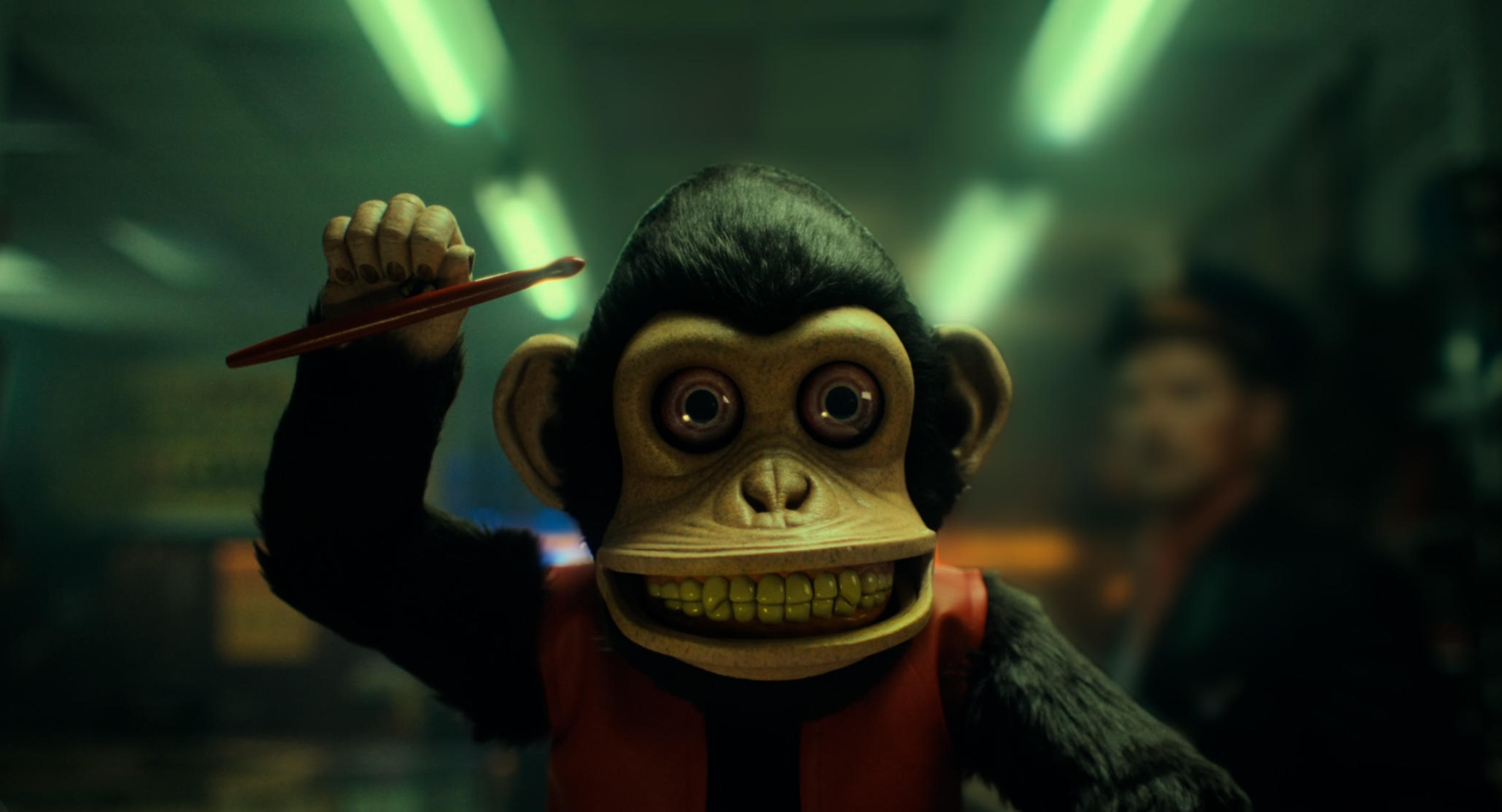The Monkey – Film Review
Published February 22, 2025

Osgood Perkins’ The Monkey brings Stephen King‘s 1980 short story to the screen, transforming its chilling premise into a psychological horror film laced with dark humor. Starring Theo James in a dual role as estranged twin brothers, the film explores the nightmarish consequences of a cursed toy monkey that orchestrates gruesome deaths whenever its mechanical hands start drumming. With a strong cast, an unsettling atmosphere, and a narrative that attempts to balance terror with absurdity, The Monkey presents an intriguing but uneven blend of psychological horror and pitch-black comedy.
King’s original short story is a lean and eerie tale, primarily focused on the monkey’s malevolent influence on a single family. Perkins expands on this foundation, delving into the psychological trauma that lingers over the Shelburn twins. The film is at its strongest when it leans into its unsettling atmosphere—Perkins, known for slow-burn horror like The Blackcoat’s Daughter and Longlegs, crafts a dread-filled world where fate seems inescapable, and each wind of the monkey’s key inches closer to doom.
However, this expansion of the narrative also introduces pacing issues. The film shifts between past and present, chronicling Hal and Bill’s childhood encounters with the cursed toy, their gradual separation, and their adult lives haunted by lingering trauma. While this structure allows for deeper character exploration, it also results in a sluggish middle section where tension occasionally stalls. Perkins seems torn between methodical psychological horror and outright supernatural terror, and the result is a film that doesn’t fully commit to either.
Theo James delivers a commendable effort in portraying both Hal and Bill, bringing nuance to their contrasting personalities—Hal, the guilt-ridden and introspective twin, and Bill, the resentful and manipulative counterpart. The film’s psychological depth is strongest in their interactions, particularly in the later scenes where their fractured brotherhood comes to a head. That said, the digital effects used to place both James characters in the same frame are occasionally distracting, pulling the viewer out of the eerie atmosphere.
Colin O’Brien, playing Hal’s son Petey, serves as the emotional anchor of the film, attempting to piece together his father’s secrets while forging his own identity. His performance adds much-needed warmth to the film’s bleak tone. Tatiana Maslany, as the twins’ mother Lois, delivers a strong but underutilized performance, mainly existing in flashbacks that reinforce the cycle of familial tragedy. Rohan Campbell’s Ricky is an interesting addition to the story, but his character arc feels underdeveloped, serving as more of a plot device than a fully fleshed-out individual.
Elijah Wood and Adam Scott, in supporting roles, provide some of the film’s drier comedic moments, though the tonal shifts between horror and dark humor don’t always land seamlessly.
The blend of horror and dark comedy is an interesting choice, but it’s one that The Monkey struggles to fully master. The film excels in crafting eerie set pieces—Perkins uses shadows, off-kilter angles, and oppressive silence to build tension before the monkey’s infernal drumming shatters the moment. Some death sequences are genuinely shocking, executed with brutal creativity. However, the humor often feels at odds with the film’s more somber themes. Unlike Evil Dead-style horror-comedies, where the absurdity enhances the terror, The Monkey oscillates between unsettling psychological horror and moments of almost cartoonish absurdity, making it difficult to fully engage with either tone.
The film’s mythology-building is another aspect that feels both ambitious and flawed. While King’s original short story left much of the monkey’s origins ambiguous, Perkins attempts to provide deeper lore, introducing hints of an apocalyptic or supernatural force tied to the toy. While intriguing, these additions feel underdeveloped and raise more questions than they answer. The inclusion of the Pale Horseman figure is a fascinating visual choice but ultimately lacks clear narrative payoff.
The cinematography is rich with decayed Americana, from dimly lit antique shops to isolated rural houses, reinforcing the film’s themes of inevitable doom and the past’s inescapable grip. The use of color is striking—cold, muted tones dominate the film, broken up by stark red accents that foreshadow impending violence. The monkey itself is effectively creepy, with its chipped paint, glassy eyes, and jarring movements amplifying its eerie presence.
The sound design is one of the film’s strongest elements. The rhythmic, hollow drumming of the monkey is used sparingly but effectively, serving as an auditory harbinger of death. The musical score, composed of discordant strings and melancholic piano, enhances the film’s brooding atmosphere but occasionally veers into over-dramatic territory.
The film builds toward a chaotic, blood-soaked climax that attempts to deliver both emotional resolution and sheer horror spectacle. While the carnage is visually impressive, the emotional weight of the final confrontation between Hal and Bill is somewhat lost amidst the over-the-top destruction. The brothers’ reconciliation feels rushed, and Bill’s fate, while shocking, lacks the tragic impact it should have.
The Monkey is a film with a fascinating premise, eerie atmosphere, and some strong performances, but it struggles to balance its psychological horror with its comedic elements. Perkins’ direction ensures that the film is visually engaging and dripping with dread, yet the script’s slow pacing, occasional tonal misfires, and underwhelming resolution hold it back from true greatness.
While ambitious and occasionally chilling, The Monkey ultimately falls short of its full potential, leaving viewers with more questions than lingering dread.
